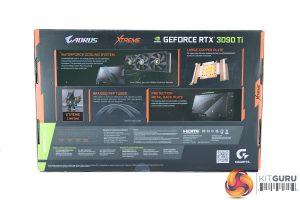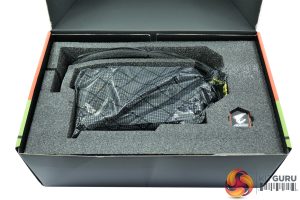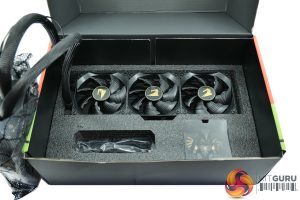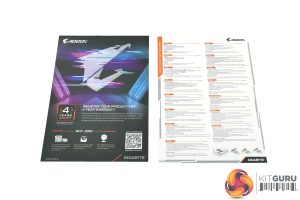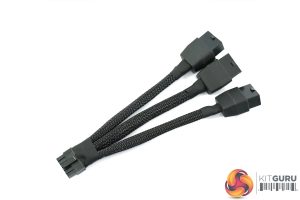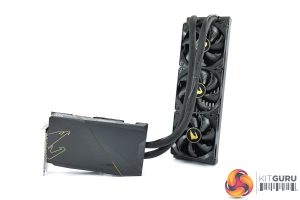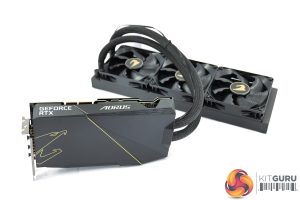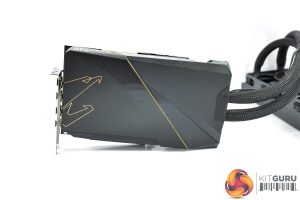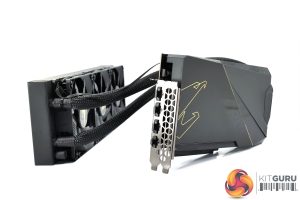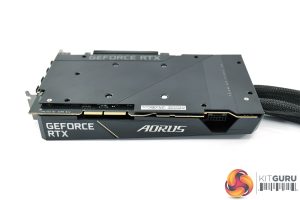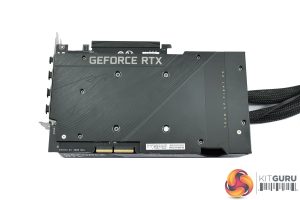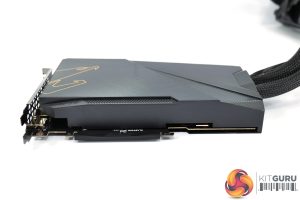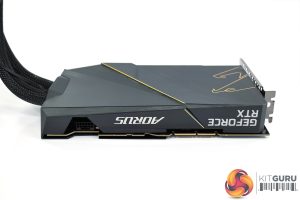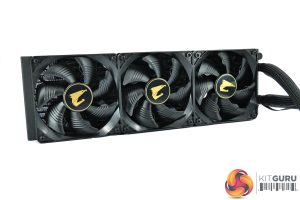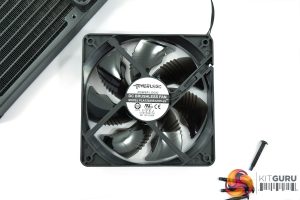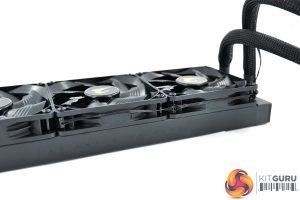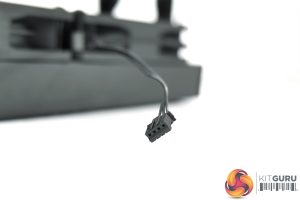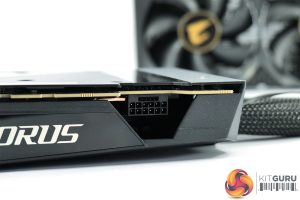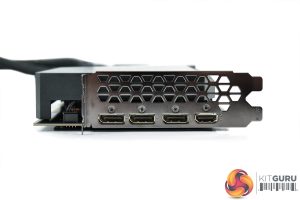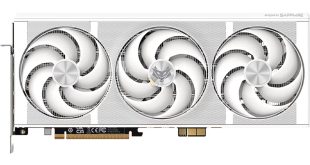The Gigabyte Aorus RTX 3090 Ti Xtreme Waterforce ships in a large black box, with a large Aorus logo on the front and various key features of the card visible on the back.
Inside, the card and cooler come well packaged, with plenty of foam used to keep things secure in transit. My sample was shipped direct from Taiwan and arrived in perfect condition.
Inside, we don't get much in the way of included accessories, which is potentially disappointing for some when considering the asking price. We find a warranty note and power adaptor for the 16-pin PCIe Gen5 connector, as well as a Batman-style Aorus action figure.
That means there's no GPU support bracket, or fancy screwdriver set as comes with the Sapphire RX 6900 XT Toxic, or a mousepad etc. It doesn't matter in the grand scheme of things, but when you're spending so much on a product, it's nice to get a few useful extras in the box.
As for the card’s design and the cooler setup, we have a pretty stealthy overall look. Everything is entirely black, with just some gold accents in the form of the Aorus logo. The card’s shroud is made out of plastic with one brushed metal section, while there is a full-length metal backplate too.
I do have to say however, actual build quality in the hand doesn’t feel super premium – some of the plastic feels just a touch creaky. It’s not the end of the world as you won’t touch the card once it’s installed, for £2100 I would have expected an all-aluminium shroud.
It’s good to see the card itself isn’t that big though, as it’s a standard dual-slot thickness and measures 238mm long and 141 mm tall. Of course, we then need to factor in the 360mm radiator however, with its 460mm long tubing, so it’s definitely worth checking this will fit in your case.
On that topic, you’ll see from the video that the only way I could get this card installed in the MSI Velox 100p Airflow, is by mounting the fans and radiator to the outside of the front panel – I’ve already got a 360mm CPU cooler in the roof, so things were a bit tight on space, but this setup got the job done.
As for the AIO itself, I’ve asked Gigabyte who the OEM is but haven’t yet heard back, so I’ll update this section of the review if we do get confirmation. Speaking with KitGuru’s resident modder and reviewer James Dawson, however, he reckons the radiator looks similar to a Cooler Master design, but that’s just an educated guess right now.
What we do know however is that Gigabyte is using a single copper base plate to contact with the VRM, GPU and memory, with the heat pulled away by the liquid cooler, so there’s no secondary fan on the card itself.
As for the fans, these are of course 120mm in size, and Gigabyte is using Powerlogic units here, with model code ‘PLA12025B12HH-LV'. They look fairly typical, with glossy black fan blades, but I’m not too keen on the fact that they use proprietary connectors. You could still swap the fans out for other models and connect them to your motherboard, but considering Gigabyte is using 4-pin connectors anyway, it would have been good for these to be standard PWM headers for ease of use.
On that topic as well, the fan cable looks a bit naff running on the outside of the AIO tubing – I would have liked this to be tucked inside one of the tubes, or at the very least, have it sleeved, as it just looks a bit lazy to me as it is, which is only exacerbated due to the price tag.
The only other thing about the fans is that, by default, they are mounted to the underside, or tube-side, of the radiator, suggest that Gigabyte intends for the radiator to be installed in the roof of your case. Of course, you can unscrew the fans and flip them around like I did, so they’re intaking from the front of the chassis.
Back to the card, we can note another 16-pin PCIe Gen5 connector, with an adaptor supplied as shown above. We can also see three DP 1.4 and 1x HDMI 2.1 video outputs.
That’s it for the design of the card, and while it is certainly fine, I do feel a bit underwhelmed considering the price point. There’s no dual-BIOS for instance, which I think is a big omission for any GPU priced over £500, let alone a liquid cooler RTX 3090 Ti. There's also no RGB either – considering the design of the Aorus RTX 3090 non-Ti Waterforce has plenty of RGB on the card, as well as RGB radiator fans, this feels like a step back to me – though that does depend on your view of RGB lighting.
Personally I think if you’re spending this much on a liquid cooled GPU, it’s safe to say you want to make a statement with your graphics card, and to me this just feels a little plain.
 KitGuru KitGuru.net – Tech News | Hardware News | Hardware Reviews | IOS | Mobile | Gaming | Graphics Cards
KitGuru KitGuru.net – Tech News | Hardware News | Hardware Reviews | IOS | Mobile | Gaming | Graphics Cards



